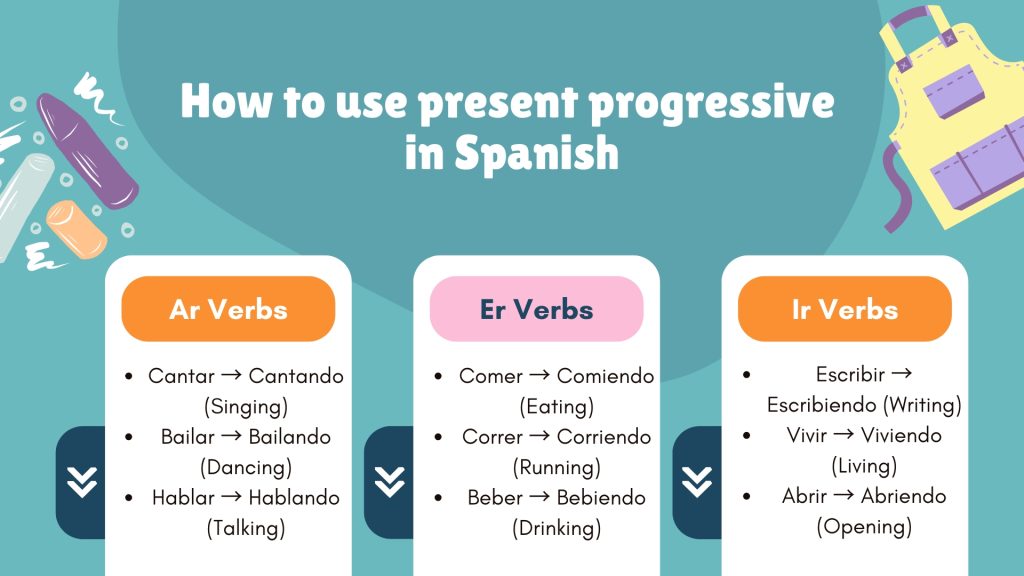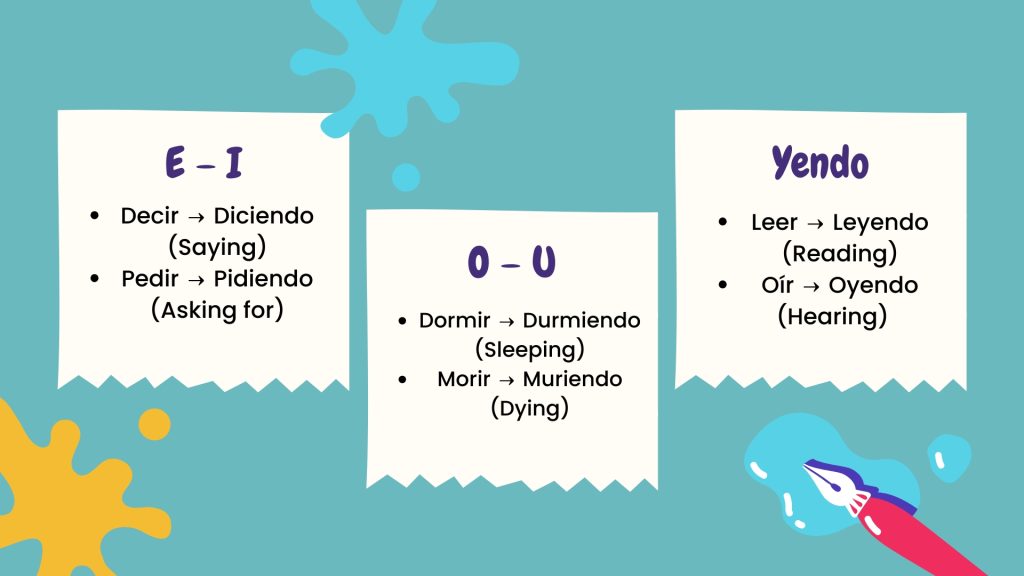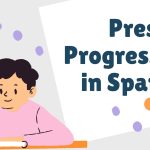The present progressive tense is key in Spanish for talking about what’s happening right now. You form it by using the right form of ‘estar’ and adding ‘ando’ for -ar verbs, or ‘iendo’ for -er and -ir verbs. It’s a bit like the English version, but getting it right in Spanish really helps you speak more fluently and fit in better with native speakers. So, what should you watch out for when using this tense?
Well, it’s easy to slip up. Sometimes people use it when they should just use the simple present tense. This can make your Spanish sound unnatural because native speakers don’t always use the present progressive for routine actions. It’s also good to double-check the verb ending. Mixing up ‘ando’ and ‘iendo’ is a common mistake that can confuse whoever you’re talking to. And remember, keeping your sentences clear and straightforward will help you communicate better.
What is present progressive in Spanish?
The present progressive in Spanish shows actions happening right now. It’s like when we use ‘am,’ ‘is,’ or ‘are’ with ‘ing’ in English, like ‘I am walking’ or ‘she is talking.’ This tense helps us talk about things that are happening as we speak. It captures what’s going on in the moment and gives us a feel of the action continuing.
How to use present progressive in Spanish
In Spanish, to form the present progressive tense—which shows an action happening right now—you simply use the verb ‘estar’ and add a bit of a twist to the main verb. First, you change ‘estar’ to fit the subject. Then, if your main verb ends in -ar, you add ‘ando’ to the end; for verbs ending in -er or -ir, you use ‘iendo.’

To form it, use:
estar (to be) + verb ending in -ando / -iendo
Example:
- Estoy escribiendo. → I am writing.
| Spanish Sentence | English Translation |
|---|---|
| Estoy escribiendo un libro. | I am writing a book. |
| Ellos están bailando en la fiesta. | They are dancing at the party. |
| Estamos comiendo pizza. | We are eating pizza. |
| Tú estás estudiando para el examen. | You are studying for the exam. |
| El perro está durmiendo en la cama. | The dog is sleeping on the bed. |
| Mis amigos están jugando fútbol. | My friends are playing soccer. |
| El bebé está llorando. | The baby is crying. |
| Estoy escuchando música. | I am listening to music. |
| La profesora está explicando la lección. | The teacher is explaining the lesson. |
| Los niños están dibujando en la pizarra. | The kids are drawing on the board. |
Ar Verbs
For -ar verbs, drop -ar and add -ando.
Examples:
- Cantar → Cantando (Singing)
- Bailar → Bailando (Dancing)
- Hablar → Hablando (Talking)
Example sentence:
Estamos bailando en la fiesta. → We are dancing at the party.
Er Verbs
For -er verbs, drop -er and add -iendo.
Examples:
- Comer → Comiendo (Eating)
- Correr → Corriendo (Running)
- Beber → Bebiendo (Drinking)
Example sentence:
Ellos están corriendo en el parque. → They are running in the park.
Ir Verbs
For -ir verbs, drop -ir and add -iendo.
Examples:
- Escribir → Escribiendo (Writing)
- Vivir → Viviendo (Living)
- Abrir → Abriendo (Opening)
Example sentence:
- Estoy escribiendo un libro. → I am writing a book.
Dive deeper into the rules of the Past Subjunctive in Spanish grammar.
Irregular verbs
Not all verbs follow the simple -ando and -iendo rules. Some verbs change their stem or adjust their spelling to maintain proper pronunciation. These irregularities occur mostly in -ir verbs, where vowels shift or extra letters are added. Let’s break it down

E – I
Some -ir verbs change e → i in the stem.
Examples:
- Decir → Diciendo (Saying)
- Pedir → Pidiendo (Asking for)
- Servir → Sirviendo (Serving)
Example sentence:
- Ella está diciendo la verdad. → She is telling the truth.
O – U
Some -ir verbs change o → u in the stem.
Examples:
- Dormir → Durmiendo (Sleeping)
- Morir → Muriendo (Dying)
Example sentence:
- El gato está durmiendo en la cama. → The cat is sleeping on the bed.
Yendo
If the stem of an -er or -ir verb ends in a vowel, change -iendo → -yendo.
Examples:
- Leer → Leyendo (Reading)
- Oír → Oyendo (Hearing)
- Construir → Construyendo (Building)
Example sentence:
- Estamos leyendo un libro interesante. → We are reading an interesting book.
When to Use the Present Progressive
Knowing when to use the present progressive in Spanish is key if you want to talk about things that are happening right now. This tense helps you describe ongoing actions.
For example, you can say ‘Estoy estudiando’ to mean ‘I am studying’, or ‘Estás cocinando’ to tell someone ‘You are cooking’. It’s great for showing that something is happening as we speak.
| Spanish Sentence | English Translation |
|---|---|
| Ella está hablando por teléfono. | She is talking on the phone. |
| Mi amigo está estudiando para el examen. | My friend is studying for the exam. |
| Los niños están jugando en el parque. | The kids are playing in the park. |
| Estoy preparando la cena. | I am preparing dinner. |
| Ellos están mirando una película. | They are watching a movie. |
| Tú estás limpiando tu habitación. | You are cleaning your room. |
| Nosotros estamos viajando a la playa. | We are traveling to the beach. |
| El gato está persiguiendo un ratón. | The cat is chasing a mouse. |
| Mi hermano está lavando el coche. | My brother is washing the car. |
| Ustedes están cantando en el coro. | You all are singing in the choir. |
When NOT to use the present continuous
The present progressive tense is great for talking about things happening right now. But, it’s not the best choice for regular habits or universal truths. Instead, use the simple present for these.
For example, say ‘She reads every night’ to talk about a routine, or ‘Water boils at 100 degrees Celsius’ to state a fact. These examples aren’t about temporary actions; they’re about regular or fixed realities.
| Spanish Sentence | English Translation |
|---|---|
| Mañana estoy viajando a México. (Incorrect) | Tomorrow I am traveling to Mexico. (Wrong) |
| Él está trabajando en un banco. (Incorrect) | He is working in a bank. (Wrong for habits) |
| Cada domingo estamos yendo a la iglesia. (Incorrect) | Every Sunday we are going to church. (Wrong) |
| Siempre estás diciendo la verdad. (Incorrect) | You are always telling the truth. (Wrong for general truths) |
| Ella está siendo una buena persona. (Incorrect) | She is being a good person. (Wrong, use ‘es’) |
| Los estudiantes están sabiendo la respuesta. (Incorrect) | The students are knowing the answer. (Wrong, use ‘saben’) |
| Nosotros estamos teniendo una casa. (Incorrect) | We are having a house. (Wrong, use ‘tenemos’) |
| Ustedes están queriendo más comida. (Incorrect) | You all are wanting more food. (Wrong, use ‘quieren’) |
| Ellos están pareciendo felices. (Incorrect) | They are seeming happy. (Wrong, use ‘parecen’) |
| Tú estás necesitando ayuda. (Incorrect) | You are needing help. (Wrong, use ‘necesitas’) |
Find out how to say “You’re beautiful” in Spanish and charm your loved one.
Conclusion
To put it simply, learning the present progressive tense in Spanish is key when you’re talking about actions happening right now.
You make it by using the verb ‘estar’ plus a gerund. This lets you describe ongoing activities clearly.
It’s good to know when to use this tense and when not to, so you can communicate more clearly and effectively in Spanish.
This helps you talk about things as they’re happening, making your conversations more lively and accurate.
Discover more insightful reads by visiting Lingua Viva regularly.
Dayron is co-owner, and the heart of Lingua Viva. He is a licensed Educator and Interpreter with 15+ years of experience, and holds a graduate degree in Foreign Language Instruction. A native Caleño who creates a comfortable environment for his students. Dayron is loved by all and inspires confidence in his students when learning and speaking Spanish. He is also an avid comedian that loves to dance salsa.











